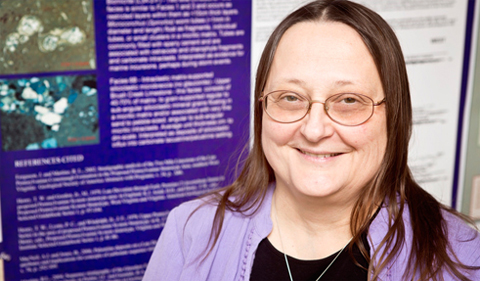Dr. Elizabeth Gierlowski-Kordesch, Professor of Geological Sciences at Ohio University, presents a poster on “Microconchids in Terrestrial to Marine Transitions” at the Geological Society of America annual meeting Nov. 1-4 in Baltimore.
Her co-author is Christopher Cassie of Encana Oil and Gas Inc.
Abstract: “Spirorbis” worm tubes, described from the geologic record spanning the Silurian through the Middle Jurassic, have been preserved in freshwater to brackish to marine sedimentary successions. This simple invertebrate’s true living paleoenvironment could not span all possible salinities. Now interpreted as phoronid worm tubes of microconchid origin, restricted today to marine conditions, the detailed study of their fossil distribution with respect to local sedimentology as well as their biologic characteristics, including osmoregulation, sheds light on their true growth paleoenvironment. Literature on over three hundred localities worldwide covering Paleozoic to Middle Jurassic marine-influenced sites and lacustrine sites were searched and those containing microconchid fossils ranging from “freshwater to marine” interpretations were documented; data collection included presence or absence and morphology of these worm tubes, their preservation mode as transported or in life position, and their associated fauna and flora along with paleoenvironmental interpretation. Microconchid worm tubes are not documented from any purely freshwater continental paleoenvironment unconnected to the ocean. Fossil occurrences of microconchid tubes are in association with coastlines, whether within a nonmarine-marine transition or a distal transition floodplain within a low-gradient coastal area potentially affected by rare marine incursions. Most coastal environments can alternate between fresh and saline waters over various time periods promoting easy mixing of marine and freshwater species leading to mixed preservation in the geologic record. Microconchids could appear to be euryhaline in such sedimentologic conditions. The biology of this invertebrate, however, supports a solely marine affinity because of its need for osmoregulation within marine salinities throughout the Phanerozoic. Opportunistic settling on hard substrates or plants with tube growth occurring within minutes during larval settlement might be similar to modern spirorbid polychaete worms. Microconchid worm larvae could settle anywhere where currents existed along a coastline and as far inland as storm surges could go, but only survived within true marine conditions and were not freshwater fauna.




















Comments